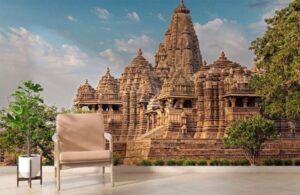Korean Wallpaper: Transforming Spaces with Elegance and Culture

Wallpaper has been a staple in interior design for centuries, and it has evolved over time to reflect changing trends, cultures, and technologies. Korean wallpaper or “Hanji” wallpaper, is a unique and culturally rich option for interior decor that combines elegance and tradition. In this detailed exploration, we will delve into the world of Korean wallpaper, examining its history, materials, design aesthetics, and the remarkable ways it can transform and elevate living spaces.
History and Tradition:
Korean wallpaper, often referred to as Hanji wallpaper, has deep roots in Korean culture and history. Hanji, meaning “Korean paper,” is a traditional paper-making technique that dates back over a thousand years. It is made from the inner bark of the mulberry tree, known for its exceptional durability and quality. This ancient craft not only showcases Korean craftsmanship but also reflects the nation’s commitment to preserving its cultural heritage.
Materials and Craftsmanship:
The hallmark of Korean wallpaper is its use of Hanji paper, which is meticulously handcrafted through a labor-intensive process. The process involves collecting the bark, soaking it, and pounding it into a pulp. This pulp is then carefully spread onto screens, dried, and peeled off in thin, translucent sheets. These sheets of Hanji paper are the foundation of Korean wallpaper.
The making of Hanji paper is not just a mechanical process; it’s a labor of love and skill. The artisans involved in its creation bring centuries of knowledge and expertise to produce a paper that is both durable and incredibly beautiful.
Design Aesthetics:
Korean wallpaper is celebrated for its exquisite design aesthetics, often characterized by delicate and intricate patterns. These patterns draw inspiration from Korea’s rich cultural heritage, including motifs from traditional clothing, ceramics, and paintings. The designs may feature elements such as flora and fauna, abstract patterns, and calligraphy, all of which carry deep symbolic and cultural significance.
One of the notable design techniques in Korean wallpaper is the use of natural dyes and pigments. These natural materials give the wallpaper a unique, earthy color palette that is both vibrant and soothing. The combination of Hanji paper and natural dyes results in a harmonious marriage of texture and color that is both timeless and elegant.
Applications and Transformations:
Korean wallpaper is a versatile design element that can be used in various settings to create stunning transformations. Here are some key applications:
1. Home Interiors:
Korean wallpaper can add an air of sophistication to home interiors. Whether it’s used as an accent wall in the living room or as a backdrop for a bedroom, the unique textures and designs of Korean wallpaper can elevate the overall ambiance of any space.
2. Commercial Spaces:
Restaurants, hotels, and retail establishments often use Korean wallpaper to create a distinctive atmosphere. The incorporation of Hanji wallpaper can help define the style of the space, making it more inviting and memorable for patrons and customers.
3. Cultural Centers:
Given its strong connection to Korean tradition and culture, Korean wallpaper is often featured in cultural centers, museums, and exhibition spaces. It serves as a beautiful backdrop for displaying art, artifacts, and cultural exhibits.
4. Spiritual Spaces:
Korean wallpaper is also seen in spiritual settings, such as temples and meditation rooms. The serene and contemplative qualities of the wallpaper make it an excellent choice for such environments.
Maintenance and Longevity:
Korean wallpaper is not only visually appealing but also durable. The Hanji paper is resilient, and the natural dyes used in the wallpaper’s creation are known for retaining their vibrancy over time. Cleaning is relatively straightforward, involving gentle dusting and occasional spot cleaning. When properly maintained, Korean Blinds can last for many years, making it a sustainable choice for interior decor.
Conclusion:
Korean wallpaper, with its rich history, use of traditional materials, and stunning design aesthetics, is a testament to the timeless allure of Korean culture. It transcends mere decoration and serves as a bridge between the past and the present, between tradition and innovation. The elegance and sophistication of Korean wallpaper make it a remarkable choice for transforming living spaces, adding a touch of cultural depth and visual appeal to any room.
By incorporating Korean wallpaper into your decor, you not only infuse your living space with a sense of history and artistry but also contribute to the preservation of an ancient and cherished craft. Whether you choose it for your home, a commercial space, or a cultural institution, Korean wallpaper has the power to transport you to the heart of Korea’s artistic heritage, all within the comfort of your own walls. It’s more than just wallpaper; it’s a cultural journey and an artistic statement that invites you to experience the beauty of Korea in every room you adorn.





